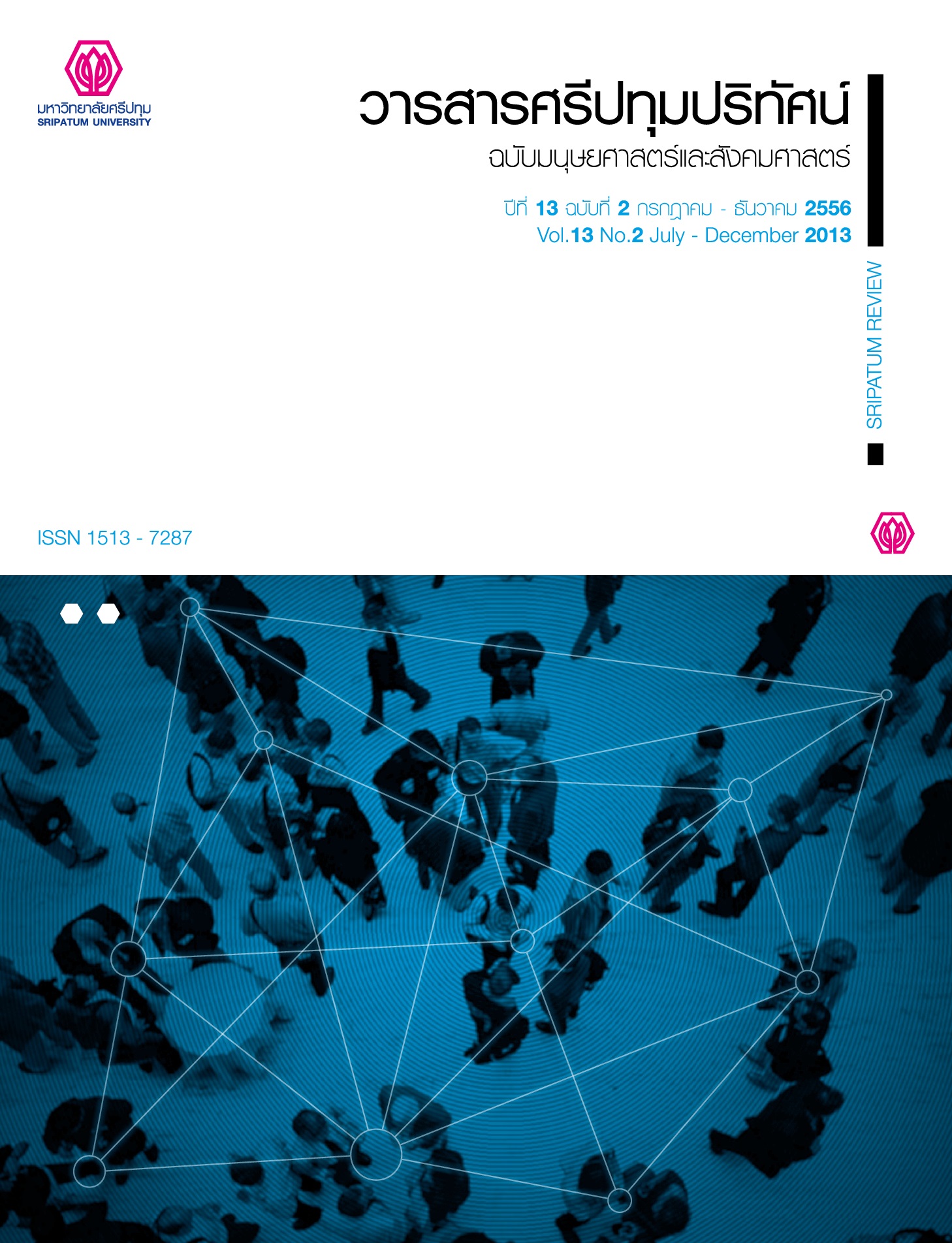A NEW PARADIGM FOR ADMINISTRATION OF HIGHER EDUCATION INSTITUTIONS IN THE THREE SOUTHERN BORDER PROVINCES: A FRAMEWORK FOR EMPHASIS ON SUSTAINABLE DEVELOPMENT AND SUPPORTING OF THE ASEAN COMMUNITY
Main Article Content
Abstract
This article reveals the framework for administration of higher education institutions in the three southern border provinces with emphasis on sustainable development and supporting of the ASEAN community which consists of the following components: analysis of the overall environment at the local level in which the institutions are located; evaluation of resources of each institution; and comparative analysis of the current condition of the institutions and the condition of which they should be in the future. This framework is to determine new strategies and administrative models taking into consideration the concepts of strategic marketing, public participation, and responding to the needs of the general public concerned under the new paradigm consisting of nine dimensions.
Article Details
1. กองบรรณาธิการสงวนสิทธิ์ในการพิจารณาและตัดสินการตีพิมพ์บทความในวารสาร
2. บทความทุกเรื่องจะได้รับการตรวจสอบทางวิชาการโดยผู้ทรงคุณวุฒิ แต่ข้อความและเนื้อหาในบทความที่ตีพิมพ์เป็นความรับผิดชอบของผู้เขียนแต่เพียงผู้เดียว มิใช่ความคิดเห็นและความรับผิดชอบของมหาวิทยาลัยศรีปทุม
3. การคัดลอกอ้างอิงต้องดำเนินการตามการปฏิบัติในหมู่นักวิชาการโดยทั่วไป และสอดคล้องกับกฎหมายที่เกี่ยวข้อง
References
บุษบง ชัยเจริญวัฒนะ และคณะ. 2551. รายงานการวิจัย เรื่อง การศึกษานโยบาย มาตรการ และแนวทางการแก้ปัญหาความไม่สงบและการพัฒนาพื้นที่สามจังหวัดชายแดนภาคใต้. สงขลา: มหาวิทยาลัยสงขลานครินทร์.
ประเวศ วะสี. 2548. กระบวนทัศน์วิจัยเพื่อท้องถิ่น จุดเปลี่ยนการพัฒนา. กรุงเทพฯ: สำนักงานกองทุนสนับสนุนการวิจัย.
พิศมัย เพียรเจริญ. 2551. รายงานการวิจัย เรื่อง ลักษณะของนักศึกษาและเหตุผลที่เข้าศึกษามหาวิทยาลัยสงขลานครินทร์ วิทยาเขตปัตตานี. ปัตตานี: มหาวิทยาลัยสงขลานครินทร์
ไพฑูรย์ สินลารัตน์. 2554. ผู้นำเชิงสร้างสรรค์และผลิตภาพ: กระบวนทัศน์ใหม่และผู้นำใหม่ทางการศึกษา. พิมพ์ครั้งที่ 2. กรุงเทพฯ: โรงพิมพ์แห่งจุฬาลงกรณ์.
มหาวิทยาลัยนราธิวาสราชนครินทร์. 2555. สถิตินักศึกษามหาวิทยาลัยนราธิวาสราชนครินทร์ ประจำปีการศึกษา 2554 ภาคการศึกษาที่ 1 และภาคการศึกษาที่ 2 (ออนไลน์).
มหาวิทยาลัยอิสลามยะลา. 2554. ข้อมูลผลการดำเนินงาน มหาวิทยาลัยอิสลามยะลา ประจำปีการศึกษา 2549-2553. ปัตตานี: กองนโยบายและแผน สำนักงานอธิการบดมหาวิทยาลัยอิสลามยะลา. (สำเนา).
สำนักงานคณะกรรมการการอุดมศึกษา. 2551. กรอบแผนอุดมศึกษาระยะยาว 15 ปี ฉบับที่ 2 (พ.ศ. 2551–2565). กรุงเทพฯ: โรงพิมพ์แห่งจุฬาลงกรณ์มหาวิทยาลัย.
Clayson, E. D., Haley, A. D. (2005). Marketing Models in Education: Students as Customers, Products, or Partners. Marketing Education Review. 15(1), 1-10.
Colis, B., Van der Wende, M. 2002. Model of Technology and Change in Higher Education. Report, Center for Higher Education Policy Studies.
Covey, S. 1989. The Seven Habits of Highly Effective People. London: Simon and Schuster.
Denman, D. B. (2005). What is a University in the 21st Century?. Journal of the Programme on Institutional Management in Higher Education. 17(2), 9-28.
Dessler, G. 2004. Management: principles and practices for tomorrow’s leaders. 3rd ed. New Jersey: Pearson Prentice Hall.
Etzkowitz, H., Webster, A., and et al. (2000). The Future of the University and the University of the Future: Evolution of Ivory Tower toEntrepreneurial paradigm. Research Policy. 29, 313-330.
Fadeeva, Z., Mochizuki, Y. (2010). Higher Education for today and tomorrow: University Appraisal for Diversity, Innovation and Change towards Sustainable Development. Sustain Journal. 5, 249-256.
Friga, N. P., Bettis, A. R., Sullivan, S. R. (2003). Changes in Graduate Management Education and New Business School Strategies for the 21st Century. Academy of Management Learning and Education. 2(3), 233-249.
Gordon, G., Whitchurch, C. (2007). Managing Human Resources in Higher Education: The Implications Of a Diversifying Workforce. Journal of theProgramme on Institutional Management in Higher Education. 19(2), 135-155.
Grant, J. (1998). A New Educational Paradigm for the New Millennium. Consciousness-Based Education. 30(7), 717-724.
Gunn, B. (1995). The Paradigm Shift in University Management. The International Journal of Educational Management. 9(1), 28-40.
Hanna, E. D. (1998). Higher Education in an Era of Digital Competition: Emerging Organizational Models. JALN. 2(1), 66-95.
Harloe, M., Perry, B. (2005). Rethinking or Hollowing out the University? External Engagement and Internal Transformation in the Knowledge Economy. Journal of the Programme on Institutional Management in Higher Education. 17(2), 29-41.
Hashim, F., Alam, M. G., Siraj, S. (2010). Information and Communication Technology for Participatory Based Decision-Making-E-Management
for Administrative Efficiency in Higher Education. International Journal of Physical Sciences. 5(4), 383-392
Hayes, T. (2007). Delphi Study of the Future of Marketing of Higher Education. Journal of Business Research. 60, 927-931.
Kiat Kok, S., Douglas, A., McClelland, B. (2009). The Assimilation of New Management Paradigms and Focus in UK Universities. The International Journal of Learning. 16(10), 637-652.
Kotler, P., Fox, K. 1995. Strategic marketing for educational institutions. 2nded. N J: Prentice Hall.
Lambrechts, W., Mula, I., Ceulemans, K., and et al. (2012). The Integration of Competences for Sustainable Development in Higher Education: an Analysis of Bachelor Programs in Management. Journal of Cleaner Production. 1-9.
Lahorgue, A. M. (2005). Managing Relations with Industry: The Case of Brazilian Universities. Journal of the Programme on Institutional Management in Higher Education. 17(2), 127-137.
Lee, C. H. (2005). The Shift of the University Paradigm and Reform of the Korean University Systems. Journal of the Programme on Institutional Management in Higher Education. 17(1), 1-14.
Paris, A. K. 2003. Strategic Planning in theUniversity. USA: University of Wisconsin.
Perkins, J. A. 1973. Organization and Function of the University as an Organization. New York: Megraw-Hill.Peterson, J. (2009). Strategic Knowledge
networks for global education. London Review of Education. 7(1), 55-70.
Richard, C. L. (2009). A New Paradigm: Strategies for Succession Planning in Higher Education. A Dissertation for the Degree Doctor of Philosophy. United
States: Capella University.
Rusinko, A. C. (2010). Integrating Sustainability in Higher Education: A Generic Matrix. International Journal of Sustainability in Higher Education. 11(3), 250-259.
Salmi, J. (2001). Tertiary Education in the 21st Century: Challenges and Opportunities. Journal of the Programme on Institutional Management in Higher Education. 13(2), 105-128.
Silman, F., Ozgit, H., Oksuzoglu, M. (2009). Personality of Organization-Case Studies of 4 Higher Education Institutions. Procedia Social and Behavioral Sciences. 1, 1858-1864.
Srikanthan, G., Dalrymple, J. (2002). Developing a Holistic Model for Quality in Higher Education. Centre for Management Quality Research. 1-7.
Svarc, J. (1999). The Need for a New University Paradigm in an Innovative Society: Implications for Croatia. European Journal of Education. 34(3), 373-382.
Taha, A. (2010). A New Paradigm for Networked Resource Sharing in the United Arab Emirates Universities. Journal of Interlibrary Loan Document Delivery & Electronic. 20, 293-301.
Vasilescu, R., Barna, C., Epure, M., Baicu, C. (2010). Developing University Social Responsibility: A Model for the Challenges of the New Civil Society. Procedia Social and Behavioral. 2, 4177-4182.
Welsh, A. (2010). Higher Education in Germany Fragmented Change amid Paradigm Shifts. German Politics and Society. 28(2), 53-71.
Wilkins, L. D. (2011). Rethinking Education: A paradigm for education for Sustainability. A Thesis Submitted in the degree of Masters of Theory and Policy
studies. Canada: University of Toronto.


